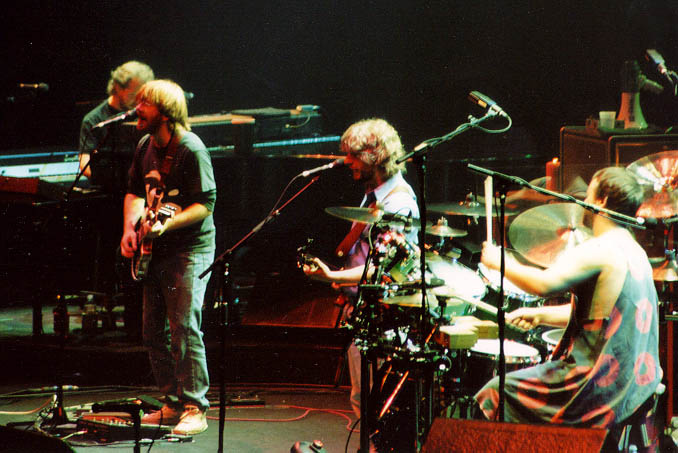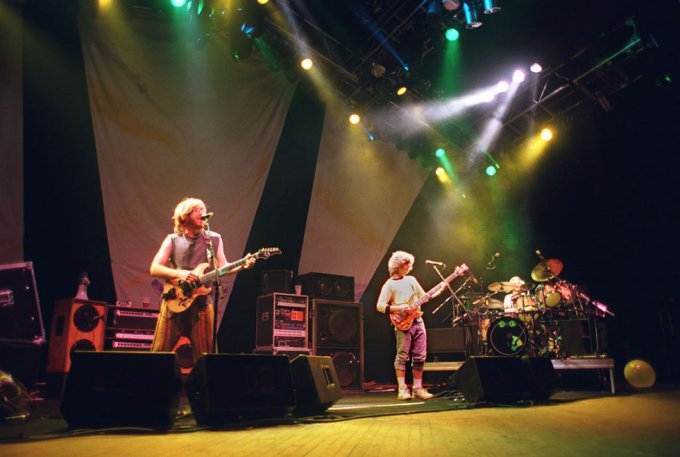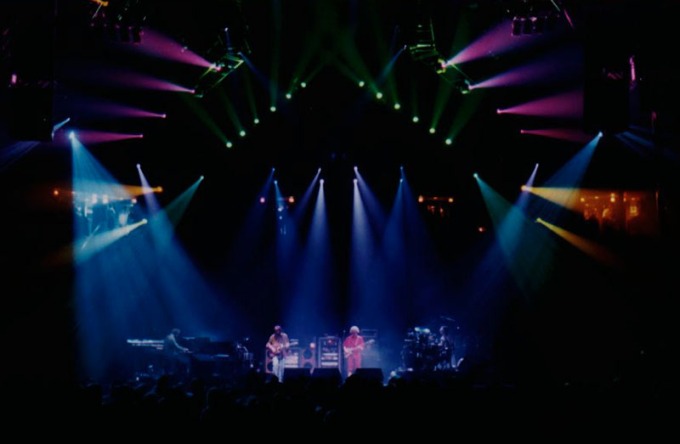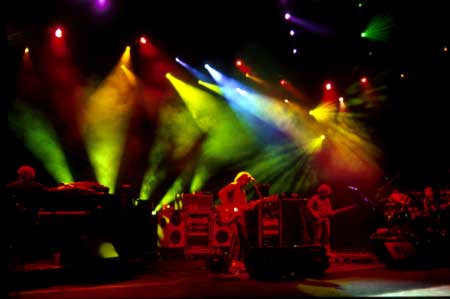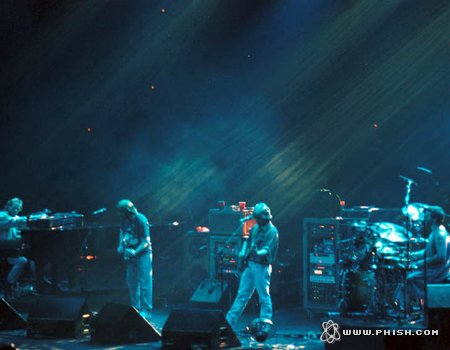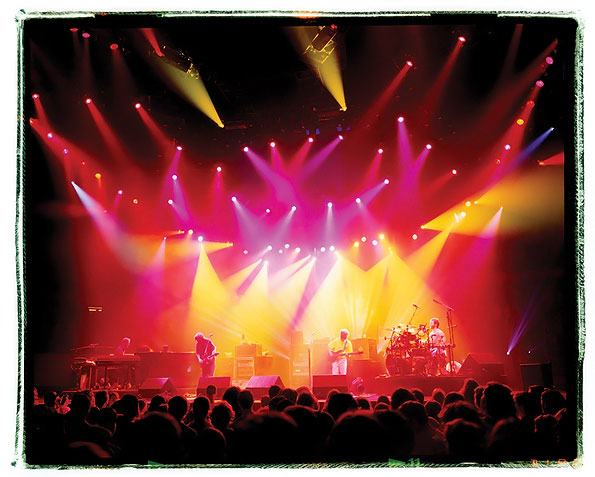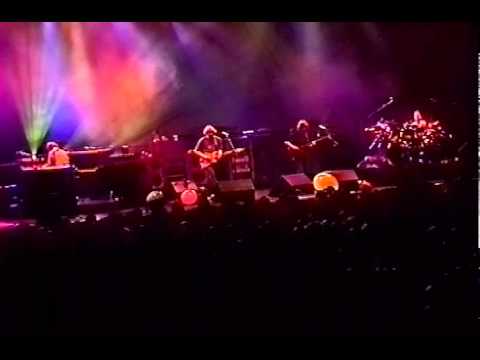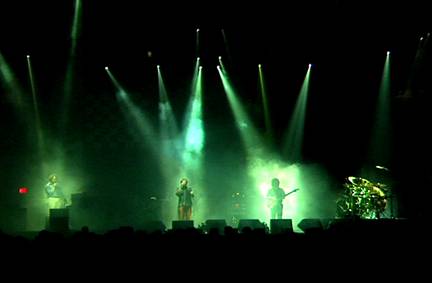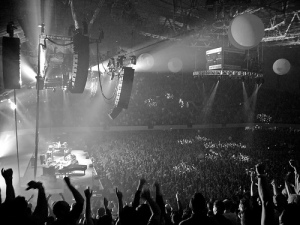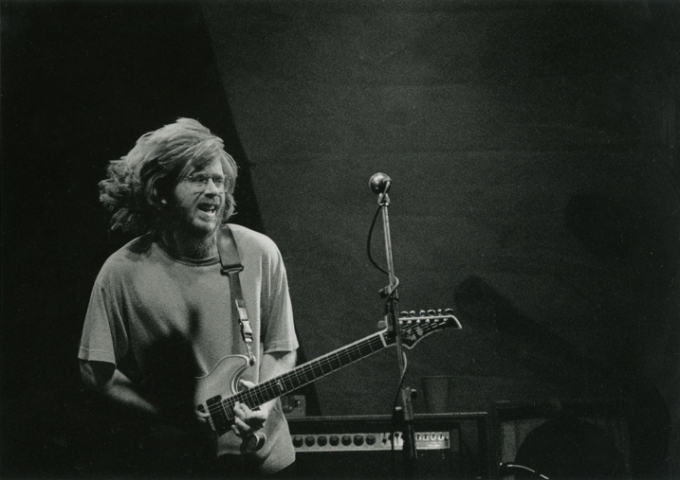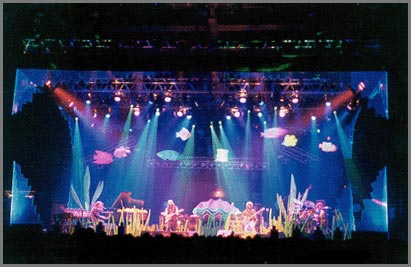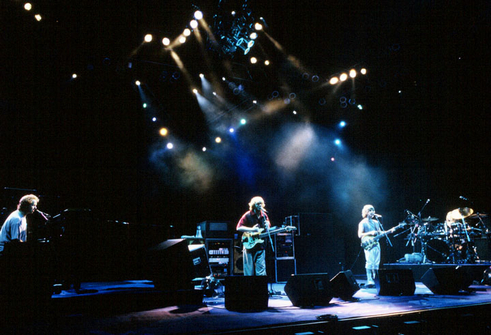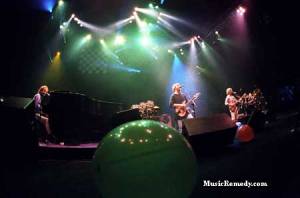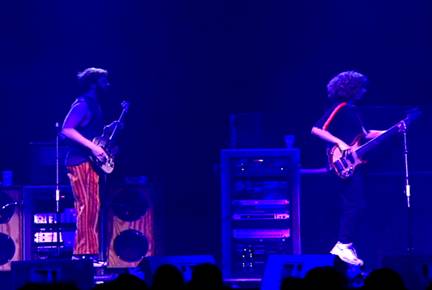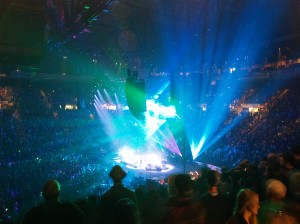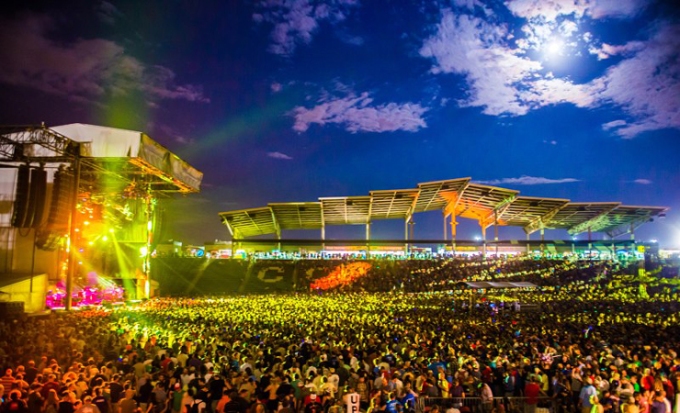 And then, after a “fifteen minute break,” they’re back.
And then, after a “fifteen minute break,” they’re back.
Whereas when Phish hits the stage prior to Set I there’s a general sense of euphoria surrounding the unknown, and the newness of being at a show again, by the time the band return’s from their setbreak, we’re all well entrenched to the experience of a Phish show. Seen in the rainbow of glowsticks scattered across the stage, there’s a more settled feeling to the onset of Set II than there is to the show’s opener. The cathartic release of Set I behind us, it’s time to get down to business. Upon entrance, the band is of course greeted once again to a rousing applause, yet here the sentiment is more one of focused energy, rather than blissful exultation.
Simply put, Set II is where shows are won and lost. And, increasingly over the last two eras of Phish, the Set II Opener is typically seen as the crux of the entire show. Perhaps the most crucial song played all night, the Set II Opener plays the role of either picking the band up right where they left off in the first set, or redirecting them into uncharted waters. Further, much of what is played in Set II, both stylistically, and song-wise, are determined specifically off their Set II Opener.
In the same way that the second set has evolved in far more dramatic ways over the years than the commonly more song-based first set, the Set II Opener has too evolved substantially. From what was once just another high-energy number out the gates, to, now, a fluid slot that can become a massive Type II jam, Set II Openers can often lead to a rock-based set, lull the crowd with a sleepy and subtle entrance, or, can surprise fans on the level of many of the shocking Show Openers. The two biggest keys that separates the Set II Opener from the Show Opener however, are the simple fact that prior to the Show Opener there’s no single part of the show played yet that can help gauge what song to play, and, the fact that the second set opener often carries a far more sinister, and “anything goes” sentiment with it. Because of this, the second set opener is certainly far more influenced by the music that came before it than the Show Opener. In essence, there are just those shows that feel like “Down With Disease,” or “Tweezer,” or “Axilla,” or “Chalk Dust Torture” need to open their second set’s.
What was once linked closely with the high-energy numbers that opened both Set I and II, the Set II Openers are now, without question, the most common slot to expect a jam from the band. In fact, in the highly unscientific perusing of my iTunes library – where I have upwards of 300 Phish shows stashed away, mind you – I discovered that, no less than 160 Set II Openers since 1995 have been a 10+ minute jam. A trend that began in the psychedelic summer of 1995, one can more or less predict that, if they’re to hear an open-ended jam while walking into a Phish show, chances are it’s gonna come during the Set II Opener.
What follows is Part IV of VIII in tackle & lines series on The Structure Of A Show. Each category contains write-ups, examples, and video clips for better understand. As with the articles on Set I, the goal of this is not to come to some sort of conclusion about what a specific Phish show is, but rather to explore the various directions the band chooses to go with their shows – here in the medium of the Set II Opener. This is not a means to rank the best openers, or the best shows, versus the weakest – though negative habits and instances will be discussed – instead it is seeking to find points of connection across various eras – and within each – while pointing out their differences. Hope you guys enjoy the piece, we’re now just a month from 03 July!
——–
I. The Classics
As with each of the other write-ups, there are just certain songs that feel like a proper Set II Opener. Be it their ability to jam, the number of times they’ve opened a second set, or just the sound they contain which fits so seamlessly with second sets, the following songs are the classics because they’re simply ubiquitous with the opening of second sets. From a purely numbers standpoint, these songs have each opened no less than 24 Set II’s, and 246 total second sets. Anyone going to a Phish show has a 15% chance of hearing one of the following six songs open a second set, no small feat.
Examples: ‘2001,’ ‘Down With Disease,’ ‘Mike’s Song,’ ‘The Curtain,’ ‘Tweezer,’ ‘Rock & Roll’
While two of the songs on this list relinquished their role as regular Set II Openers around 1996 – “2001” and “The Curtain” – statistically they’ve garnered so many appearances in this slot that to many fans they will always sound like Set II Openers. Aside from that slight technicality, there’s just something about a second set opening with a monster “Down With Disease,” “Tweezer,” “Rock & Roll,” or an old-school “Mike’s” that just feels right. Scanning the lineage of Phish’s career, there are so many classic shows, and classic second sets that opened with these songs. Off the top of my head: 12/30/1993, 03/20/1992, 08/14/1993, 06/11/1994, 06/26/1995, 10/21/1995, 12/11/1995, 12/14/1995, 08/17/1996, 11/27/1996, 08/02/1997, 08/17/1997, 11/17/1997, 11/19/1997, 12/02/1997, 12/06/1997, 12/29/1997, 07/01/1998, 07/17/1998, 08/12/1998, 08/16/1998, 12/30/1998, 07/10/1999, 07/24/1999, 07/31/1999, 10/02/1999, 06/15/2000, 06/28/2000, 07/11/2000, 09/17/2000, 02/16/2003, 02/20/2003, 02/28/2003, 07/18/2003, 07/23/2003, 08/02/2003, 12/02/2003, 12/29/2003, 08/10/2004, 08/15/2004, 03/07/2009, 03/08/2009, 05/31/2003, 08/01/2009, 08/08/2009, 08/14/2009, 12/03/2009, 12/31/2009, 07/03/2010, 07/04/2010, 08/06/2010, 10/22/2010, 10/23/2010, 12/30/2010, 05/28/2011, 06/03/2011, 08/16/2011, 09/03/2011, 09/04/2011, 06/08/2012, 06/20/2012, 06/22/2012, 06/28/2012, 08/15/2012, 08/22/2012, 12/28/2012, and 12/30/2012 all opened their second sets with one of the six above songs. Further proof that these songs are just the classic way for the band to usher in a second set.
II. The Guaranteed Jam
As was pointed out above, if you’re going to hear an open-ended jam at a Phish show, chances are you’re going to hear it in the Set II Opener. The combined released of the energy in Set I and the unknown quality to the onset of Set II lends itself perfectly to a captivating jam out the gates. Whenever the lights drop following setbreak, and the band kicks into one of the following eleven songs one’s almost guaranteed a lengthy, often experimental, wholly unique, and at times game-changing jam to be unveiled in real time.
Examples: ‘Down With Disease,’ ‘Tweezer,’ ‘Rock & Roll,’ ‘Drowned,’ ‘Ghost,’ ‘Piper,’ ‘Sand,’ ‘Bathtub Gin,’ ‘Seven Below,’ ’46 Days,’ ‘Twist’
As anyone in attendance at 08/17/1997, 02/28/2003, 08/08/2009, 09/14/2000, 09/12/1999, 07/19/2003, 09/02/2012, 11/23/1997, 06/25/2004, 06/17/2004, and 07/30/2003 can attest, once they heard one of the above songs start the second set, they knew they were in for a wild ride. While the band has been increasingly prone to cut even some of the above songs short at times here in the 3.0 era, throughout their history they’ve proven to be so ubiquitous with the concept of Phish’s improv, that one has to at least anticipate a jam emerging from them when they do in fact hear them nowadays. Regardless of current tendencies, throw on any show between 1995 and 2003 that opens with one of the above eleven songs and you’re almost guaranteed at least a 15 minute jam, and in many cases, even a 20+. For those of us who love Type II Phish, these songs, in this slot, is just where it’s at.
III. The Sinister Assault
While the role of the Set II Opener has come to represent a guaranteed jam for many-a-fan, it’s original task was similar to the Show Opener, being more of a quick punch to the eventual set. Still used from time to time – increasingly more here in the 3.0 era – the band will opt for a quick burst of energy before getting down to business. A move that initially leaves the possibilities of the set up in the air – these songs can just as easily lead to rock-based Set II’s, and they can more experimental driven ones – they’re used more to rile up a crowd, and, presumably the band, in anticipation for the set to come.
Examples: ‘Wilson,’ ‘Chalk Dust Torture,’ ‘Llama,’ ‘Buried Alive,’ ‘Axilla,’ ‘Maze,’ ‘Carini,’ ‘Split Open & Melt,’ ‘The Sloth’
While some of the above songs have been used from time-to-time as jam vehicles, their most known in this setting for their role as immediate bursts of energy to kick of a second set. Just throw on 08/07/2010, 08/06/2011, 07/13/2003, 11/27/1998, 07/08/2012, 11/14/1995, 12/28/2010, 12/07/1995, and 08/14/2010 and you’ll hear how powerful a way each of the above songs is at opening a second set. While staying more or less contained in their own structures, their energy has an undeniable affect on the set that follows, leading, in each case, to massive throwdowns. Perhaps not the most anticipated approach to a second set, these songs nevertheless prove to raise the energy of a show substantially, something that can never be argued with.
IV. The Composed Approach
In the same sense as this section in the Show Opener’s piece, the following songs are some of the band’s most cherished classics, and most fans would be absolutely thrilled to hear them open a Set II of any show they were at. While rarely featured in this slot ever since the band took on a more improvisational approach with the Set II Opener, their composed classics used to usher in numerous second sets in the band’s early years. All told, the following seven songs have combined to open 79 second sets, with “David Bowie” leading the way with 25 appearances in the slot. A monumental occasion were it to happen today, these songs represent a bygone era where the first and second set shared far more in common than they do now.
Examples: ‘David Bowie,’ ‘The Landlady,’ ‘Reba,’ ‘Stash,’ ‘The Divided Sky,’ ‘Fluffhead,’ ‘You Enjoy Myself’
A bona fide rarity in the modern age of Phish, only “Stash” and “David Bowie” remain as plausible rotational options for the Set II Opener, and even that’s a stretch. Still, as anyone who attended, or has heard 12/03/1997, 12/28/1990, 10/25/1995, 12/31/2003, 04/20/1989, 02/08/1988, or 09/21/1987 can tell you, these songs each worked in ideal fashion when thrust into the role. A welcome addition to the band’s 30th anniversary year, tossing a couple of their composed classics into the Set II Opener slot would both make Phish stat geeks go crazy, while adding some historical lore to whatever show they appeared in.
V. The Quick Punch
Akin in some ways to the sinister assault, these following ten songs distinguish themselves for the fact that, while their essential role is to provide a shot of adrenaline to a second set, they each do it with such an immediacy, such a quick burst of energy, that they’re almost forgotten by the time they’re over. Used in many ways to segue into a lengthier jam, these songs have been featured throughout the years to essentially set up a set, and wake the band and crowd back up from their setbreak lull. While a few of them have evolved into legitimate Set II Opening jams, in their origins, they were continually thought of as the quick punch that announced the onset of Set II, before fading into a lengthier jam that would come to dominate the overall set.
Examples: ‘2001,’ ‘Llama,’ ‘Buried Alive,’ ‘The Landlady,’ ‘Axilla,’ ‘Halley’s Comet,’ ‘Peaches En Regalia,’ ‘The Sloth,’ ‘Party Time,’ ‘Ha Ha Ha’
From 06/22/1994 to 07/19/1998, 02/26/1997 to 12/28/1990, 12/28/1997 to 12/01/1995 to 09/14/1999, 07/15/1992, 06/12/2011, and 12/04/1996, each of these songs have perfectly sprung us out of setbreak and into the second set with an energized kick that simply can’t be matched. Not only pulling everyone out of setbreak, they also segued into a lengthier jam, thus creating a proper bridge between reality, and the anything-goes spirit of a second set. One of the best Set II Opener’s one can hear, they generally display a fun-loving spirit for the band, almost always resulting in memorable sets.
VI. The Laid-Back Easers
Completely opposite to the previous section, these are the openers where the band takes their time easing into a set, allowing any sentiments towards the show breathe, rather than immediately diving into a jam or assaulting the crowd with energy. Often times hinting at a more contemplative mood within the band, these openers often catch a crowd off guard, yet can many times be full of rewards. Leading to potential jams, or segueing directly into a jam, these songs work in similar ways to the quick punches and the sinister assaults, yet with the opposite mood.
Examples: ‘Makisupa Policeman,’ ‘Ya Mar,’ ‘Lengthwise,’ ‘NICU,’ ‘Limb By Limb,’ ‘ ‘Waves,’ ‘The Man Who Stepped Into Yesterday’
While most fans typically correlate an opener with a high-energy number, these songs turn that theory on it’s head, while often times proving to be just as emotionally captivating as the band’s more raucous songs. Check out 12/29/1995, 12/30/1995, 08/17/2010, 12/13/1997, 07/15/1998, 02/15/2003, and 10/31/1987 to see how well these songs worked as Set II Openers. As a general rule, the unexpected is always the best approach with Phish. As each of these songs display, when the band is at their most unexpected, it’s often the best opportunity to sit back and just enjoy whatever show you’re witnessing or listening to. While a bit against the grain to their typical Set II Opener approach, the laid-back easers are, nonetheless just as engaging an entrance into the second set as any.
VII. The Old-School Hits
Some sets, and some shows just call for the old-school hits. The old reliables, some of which have been with the band since their inception, they’re the guaranteed crowd pleasers, sometimes just what the band needs to kick off a set. Sure to result in a boon of energy from the audience to the stage, these songs don’t so much create any sense of the unknown when they open a Set II, for the could just as easily open Set I, rather they’re there to trigger the remembered sensation of why we fell in love with Phish in the first place. Many of these songs are the earliest fans hear when being introduced to Phish, and, while they’re rarely the songs anyone would pick to open a second set, they do tend to add an old-school dimension to whatever show they appear in.
Examples: ‘Runaway Jim,’ ‘Suzy Greenberg,’ ‘Golgi Apparatus,’ ‘Possum,’ ‘AC/DC Bag,’ ‘Sample In A Jar’
First ballot tracks on any sort of Phish Greatest Hits, the above six songs are for the most part called upon in their Set II Opener role to remain within structure. Yet, as any fan knows, “AC/DC Bag” and “Runaway Jim” have numerous times displayed the awesome power of the Set II Opener slot, in expanding their structure, and time and again exploring the unknown. Regardless where the band takes one of these songs in this slot, few can argue with their placement on 06/16/1995, 11/02/1990, 04/27/1993, 10/26/2010, 12/30/1997, or 12/15/1999. Similar in many ways to section IX, these songs either work or they dont. When they do, they inject the show with an old-school feel, surely bolstering the show in some way.
VIII. The Unexpected Gems
While many of the songs in this section have opened their fair share of second sets, there’s always an unexpected thrill that comes with them in this slot. Rarely in a Set II Opener rotation, often times many of these are completely out of the band’s rotation all together, thus when they open a set they create a jolt of electricity to run through the venue based solely on their presence alone. Sometimes leading to a monumental jam, in reality, just the fact that many of these songs are being played is enough to up the energy of their set right from the get-go.
Examples: ‘Timber,’ ‘Crosseyed & Painless,’ ‘Tube,’ ‘Punch You In The Eye,’ ‘Boogie On Reggae Woman,’ ‘My Friend, My Friend,’ ‘Loving Cup’
Remove these seven songs from their placement on 11/28/1997, 06/21/2009, 06/24/2004, 07/23/1997, 09/18/1999, 11/27/2009, and 05/07/1994 and insert any standard opener, and you’ve got a totally different sentiment heading into the set. Upping the ante of their set and show simply with their presence, on the occasions that some of the above songs have been jammed into the unknown, they’ve essentially made their shows right then and there. Akin to the often jarring placement of an easer in the opening slot, these songs prove the power of the unexpected when it comes to Phish.
IX. The Hit Or Miss
Until this point in the essay, the songs featured have more or less been guaranteed hit’s whenever performed. Due to a combination of factors – there’s less pressure on the Set II Opener, and many develop into jams out of their song origin – more songs work as Set II Openers than Set I Openers. Here, however, we find ourself in the first section of songs that could potentially kick the set off on the wrong note. For whatever reason, the following songs either work as Set II Openers, or they don’t. And there’s little room in between. Some of the songs are the kind few would request for a second set opener, and others, while a treat to hear, rely in many ways on their ability to transform into an exploratory jam to fit within this role. Either way, whenever these songs are featured in the Set II Opener slot, fans tend to hold out hope that something will come of them, rather than just sink into the immediacy of the performance.
Examples: ‘Runaway Jim,’ ‘Suzy Greenberg,’ ‘Possum,’ ‘Birds Of A Feather,’ ‘Gotta Jibboo,’ ‘Golden Age,’ ‘Back On The Train,’ ‘Theme From The Bottom’
There are two sides to each of these songs. There’s your 08/11/1998 and 11/18/2009 “Jim,” your 10/08/1990 and 03/13/1991 “Suzy,” your 11/24/2009 and 08/02/1998 “Possum,” 06/04/2011 and 06/29/2000 “Birds,” 07/04/2000 and 08/09/2011 “Jibboo,” 06/08/2011 and 12/29/2012 “Golden Age,” 06/07/2011 and 06/14/2000 “GBOTT,” and your 11/19/1995 and 06/22/1995 “Theme.” Some of these work, some of them don’t, it all depends on the way the band is feeling, and if they find any of the magic in their performance that night. If it’s there, these songs can often times develop into a memorable moment of interplay and exploration. If not, they tend to get the set started on a tepid note that rarely transforms itself into any monumental music made later in the set.
X. The Head Scratchers
Whereas the last section at least provided opportunities for the band to redeem their Set II Opener song selection through their performance, the following songs rarely, if ever, prove to overcome the initial moment they open a set, when the venue lets out a collective, “huh?”. Akin to the crowd groan segment in the Set I Openers essay, these songs just don’t seem to have what it takes to open a second set, yet for whatever reason, the band has gone with them from time to time. Seemingly removing all energy from the venue within seconds of starting, these songs rarely offer any opportunity for Type II interplay, and instead, act as a filler, a well-defined bridge from the setbreak into the second set. The problem with them more than anything is the fact that unless they develop into something outside of their structure, they tend to cater heavily to the type of awkward and uneven sets that offer little in terms of memorability.
Examples: ‘Julius,’ ‘Sample In A Jar,’ ‘Backwards Down The Number Line,’ ‘Poor Heart,’ ‘Heavy Things,’ ‘Bouncing Around The Room,’ ‘Cars Trucks Buses,’ ‘All Of These Dreams’
Regardless how much an apologist you are for the band – and trust me, I tend to be one myself – you can’t really argue that the above eight songs are at the bottom of any fan’s wish list to open a second set. Aside from “Number Line,” none of those songs have proven to evolve into the types of unwavering jams that would make them worth hearing in this slot. Instead, as 10/15/1995, 05/19/1994, 08/05/2009, 04/07/1992, 07/08/2000, 12/17/1995, 09/27/1995, and 08/09/2004 have shown, these songs have typically kicked off some of the less “hooked-up” sets the band has played. While no one should ever discount the potential to be surprised with Phish, until this point, the above song’s track record as a Set II Opener, more or less speaks for itself.
XI. The One-Off’s
Due to the unexpected nature of Phish shows, there are those nights where you’ll hear a song in a slot it’s just never been played in before. Whether to test something out, perhaps as an opportunity to play a random cover, or just because of a wild hair the band’s got that night, from time to time the band will drop a totally unexpected song in a specific slot, only to never feature it there again. Sometimes it works, sometimes it doesn’t, more than anything it leads to anything-goes spirt that accompanies Phish in their approach to the second set.
Examples: ‘After Midnight,’ ‘Big Balls,’ ‘Camel Walk,’ ‘Character Zero,’ ‘Farmhouse,’ ‘First Tube,’ ‘Gumbo,’ ‘Harpua,’ ‘I Am Hydrogen,’ ‘Light,’ ‘Nellie Kane,’ ‘Sabotage,’ ‘Saw It Again,’ ‘Scents & Subtle Sounds,’ ‘Tweezer Reprise,’ ‘Uncle Pen’
While a few of the above songs were received with rave results, and others just didn’t seem to work, few can argue that their sheer presence as a one-time Set II Opener didn’t add a bit of variety to each of the shows they appeared in. Check out 05/31/2011, 07/03/2011, 08/04/1988, 11/26/1997, 09/28/1999, 09/20/2000, 08/03/1998, 10/28/1989, 01/21/1987, 06/11/2010, 05/29/1994, 11/21/1998, 12/12/1997, 12/04/2009, 12/15/1995, and 04/26/1991 for examples of each of the above songs being featured as Set II Openers. From the above list, one would be hard-pressed not to hope for another “After Midnight,” “First Tube,” “Gumbo,” “Harpua,” “Light,” “Sabotage,” “Saw It Again,” “Scents & Subtle Sounds,” and “Tweezer Reprise” Set II Opener at some point in the future. Fingers crossed.
XI. The One’s That Should Open More Set II’s
Related in some ways to the above section, the following songs are simply those that, while featured from time-to-time as Set II Opener’s, really deserve to be played in that slot more often. Either because they’re a guaranteed jam, or because their simple appearance in the slot would immediately raise the bar of the show they’re in, there’s just no reason the band shouldn’t try to fit these songs in the Set II Opening rotation a bit more. I guarantee these songs would go a long way to countering whatever complaints certain aspects of the fan community have about Phish’s variety, or lack thereof. Regardless of any fan agitation, these songs are just great examples of what Phish is capable of musically, and deserve more time spotlighted in THE slot of the show.
Examples: ‘Twist,’ ‘Harry Hood,’ ‘Piper,’ ‘The Sloth,’ ‘Bathtub Gin,’ ‘Seven Below,’ ’46 Days,’ ‘Waves,’ ‘A Song I Heard The Ocean Sing,’ ‘Cities,’ ‘Col. Forbin’s Ascent,’ ‘Fee,’ ‘First Tube,’ ‘Gumbo,’ ‘Light,’ ‘Saw It Again,’ ‘ Scents & Subtle Sounds,’ ‘Tweezer Reprise’
A list stacked with songs that any fan would kill to hear at any point in any show, one can’t argue that any show would be immediately bolstered by the simple appearance of one of the above eighteen songs. Check out 07/30/2003, 11/10/1989, 07/19/2004, 08/14/2010, 11/23/1997, 06/20/2004, 01/02/2003, 11/28/2003, 06/19/2004, 08/10/1997, 04/22/1988, 10/12/1989, 09/20/2000, 08/03/1998, 06/11/2010, 12/12/1997, 12/04/2009, and 12/15/1995 to hear the immediate impact each of these songs has on their sets. In an era that has proven to be the band’s most diverse and has taken more risks within their setlists that essentially any other period in their history, one wouldn’t be too far off to expect that perhaps one of the above songs would make a return to the Set II Opening slot sometime in 2013.
——–
Perhaps the most critical song played in a Phish show, the Set II Opener allows the band a veritable tablet of differing options with where to take a show. They can build off the energy in an excellent Set I, or they can redirect the show after a forgettable set. They can launch the set into the unknown, or they can display a band incapable of exploration. Regardless where the band decides to go with their second set opener, it’s clear that many shows live and die in their second sets, and that the opener directly impacts the set that will unfold. Thus concludes the fourth part in an eight-part series breaking down Phish’s live show. Up next is The Second Set.
Hope everyone enjoyed the post! Feel free to leave your thoughts, comments, suggestions, rants, etc! Thanks for reading!
